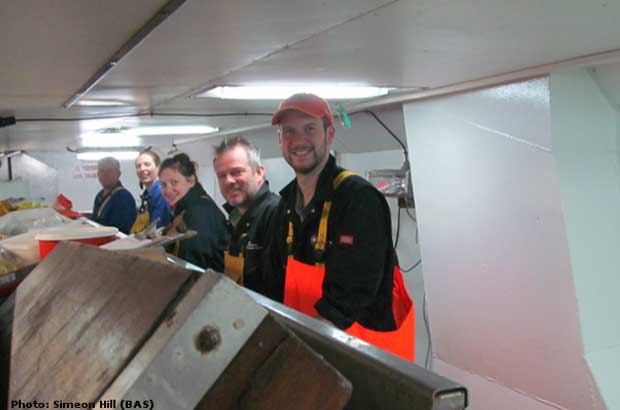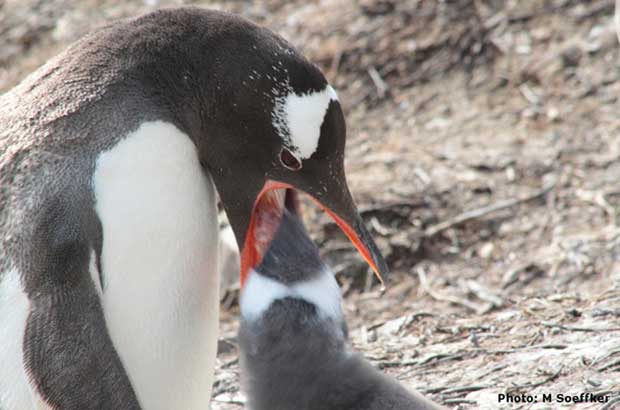It was January and therefore traditionally the time for a survey of fish stocks around the island of South Georgia, in the Southern Ocean. Since 2012, Cefas has provided scientific and technical fisheries advice to the Government of South Georgia and South Sandwich Islands. But this year was the first that Cefas joined in the survey.
This 14 day survey, led by British Antarctic Survey, included people from the University of Aberdeen, and observers from the Government of South Georgia and CCAMLR. It would cover cover over 70 stations, in an area of over 190,000 km2.

We wanted to collect data on the mackerel icefish (Champsocephalus gunnari), a sought-after species found only in the Southern Ocean. Once collected, these data feed into the stock assessment, which is used as the basis for the sustainable management of the stock’s commercial exploitation. The survey also would collect information to better understand sub-antarctic benthic fish communities. And for the first time we would deploy cameras on fishing gear, to see just how fish behave and interact with this gear.
Survey highlights and collecting data
Our first stop was at an outcrop called Shag Rocks. Visibility was excellent, and on this rare occasion their jagged shapes were seen erupting from the sea. Station after station was put into the water, haul after haul was sorted and documented. This area is characterised by high biomass and lower biodiversity, and is an important site for Patagonian toothfish (Dissostichus eleginoides) recruitment. We also encountered the first icebergs, one stretched over 12 miles! The clear water and high krill aggregations attracted krill predators, including baleen whales. And our best day saw our vessel surrounded by humpback whales passing and breaching, without taking any notice of us.

With Shag Rocks completed we steamed to the main island. The second part of the survey concentrated on the stations around South Georgia. Close to shore our ship was constantly accompanied by porpoising seals and penguins, who were keeping an eye on us. Further out the weather was stormy and harsher, but we nevertheless completed all stations without major delays thanks to the excellent crew. Plankton was noticeably more abundant here, but at last successful camera deployments were made when the visibility cleared up. The fascinating footage gave new insights on how different species interact with fishing gear.

The end is near
Over 70 stations later we had completed the survey. We headed towards King Edward Point on South Georgia to meet with the government patrol vessel. This took us back to the extraordinary Falkland Islands, where we spent some time. The station is situated near the ‘village’ of Grytviken, a former whaling station abandoned in the 1950s. And to this day the remnants stand as a monument to the last significant commercial exploitation of marine mammals in the Southern Ocean. A few of us opted to hike up Mt Hodges, where we got lucky with the weather - the views were breathtaking of Cumberland Bay and the mountain glaciers.

From there we moved to Maiviken, a small bay home to a large population of breeding fur seals. The air was filled with their bleating as we walked through the vale towards the lake, which serves as their pup playschool. Further on still the Gentoo penguins were rearing their chicks. The young were nearly as big as the adults, and yet were always chasing them for more food. The valley opened out into a beachy bay under the reign of fur and elephant seals. All too soon it was time to return to base, as night was drawing near.

At King Edward Point the survey team split apart. Half of the team remained for a few further weeks at the base, while the other half returned to the UK. Following a rather stormy and eventful crossing on the patrol ship Pharos and a few delayed flights later, I arrived back in the UK after 8 days of travelling.
The survey was a great success, with a fantastic scientific team and a terrific vessel crew. We gained new insights into fish behaviour, determined the current spread of key commercial species and obtained new data for an updated and improved stock assessment.
Science in the Antarctic
Cefas provide the Foreign and Commonwealth Office (FCO) with technical and scientific support in relation to the Commission for the Conservation of Antarctic Marine Living Resources and, where necessary, fishery issues in the broader South Atlantic and Antarctic areas. We further provide the Government of South Georgia and the South Sandwich Islands (GSGSSI) with stock assessments within its maritime zone, and with general fisheries science and management advice. Cefas works closely with the British Antarctic Survey, who have a long-standing history of science and monitoring in the Antarctic and maintain the King Edward Point research station on South Georgia.
For updates please sign up to email alerts from this blog, email me or you can follow us on Twitter @CefasGovUK.
1 comment
Comment by Earthobservation posted on
Excellent blog & thanks for sharing experience for fishing survey habitat at island of South Georgia.The survey given the better information to understand sub-antarctic benthic fish communities too.
http://www.earthobservation.ie/survey